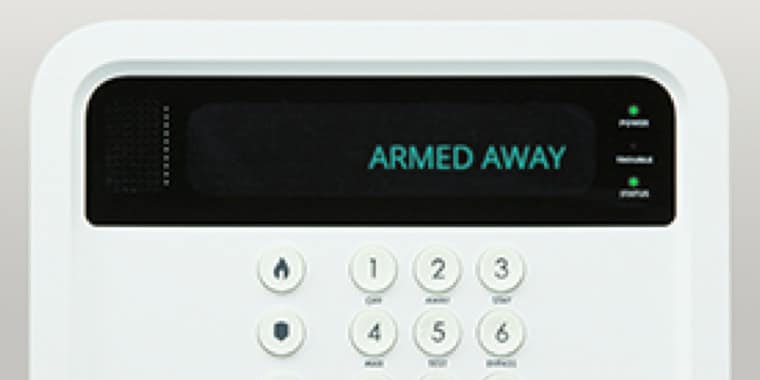No one wants to believe that a catastrophic fire event can happen to them, but fires unfortunately affect many families every year. According to U.S. Fire Administration data for 2019, there were over 350,000 residential fires resulting in over 2,500 deaths, 12,500 injuries and 7 billion dollars in losses and property damage*.
Fire can spread rapidly through your home, leaving you as little as one or two minutes to escape safely once the smoke alarm sounds. Having a fire safety plan, and preparing ahead for such an event, is critical. However, according to the Red Cross, only about 10 percent of families have practiced a fire escape plan.
The National Fire Protection Association (NFPA) suggests that you install smoke alarms in every sleeping room, outside each separate sleeping area and on every level of the home. Be sure to test the batteries in your fire alarms regularly. Get help replacing your ADT system batteries in our Help Center. ADT adds an extra layer of protection to your fire plan by monitoring for signs of fire and alerting you and the fire department immediately upon detection.
Here are the 5 steps you can take to be prepared in the event of a fire emergency.
1. Communicate
Be sure you and your family members know exactly what to do in the event of a fire. When all family members know the exit plan, there’s a much better chance of everyone making it out safely. Households with children should consider drawing a floor plan of your home, marking two ways out of each room, including windows and doors. Also, mark the location of each smoke alarm.
Calmly educate young children about the dangers of a house fire, and share what to look for in case of a fire emergency. Have them help create the escape plan so they can visualize it. Teach all children how to dial 9-1-1 and ask for help.
2. Establish Roles
If you have an infant or a senior in your home, establish who in your family will assist them during an emergency. Most children over the age of three can recognize the sound of a smoke alarm. However, they still need help from an adult or older sibling to exit safely. It’s estimated that only 1 in 5 households with children ages 3–17 have a fire safety plan, making established roles more important.
Households with people with disabilities tend to be better prepared for an emergency, with 70% having an evacuation plan. But people with mobility limitations might have trouble identifying another way out if one way is blocked. Assign someone to assist a family member with disabilities in the event of a fire. Assign a backup person too, in case the first assignee isn’t home during the emergency.
3. Identify all Exits
Whether you’re in an apartment or a single-family home, identify which exits should be taken in an emergency. There should be two ways out of each room. Check to make sure the escape routes are clear of obstacles, and that doors and windows can be opened easily. If windows or doors in your home have security bars, make sure the bars have emergency release devices inside so they can be opened immediately. Prepare a floor plan for your kids to help them make sense of the route.
If your home has two floors, every family member including children must be able to escape from the second floor rooms. Escape ladders can be used to provide an additional escape route. Review the manufacturer's instructions carefully and practice ahead of time so you'll be able to use a safety ladder in an emergency.
If you live in an apartment building or high-rise complex, know your exit plan and stay low. Never use the elevator. If you can’t get to the hallway because of smoke or fire, call your fire department and tell them your exact location. Close all doors around you and create a seal around the door with duct tape, towels, blankets or whatever is available to you. If you’re in a room with a window, stay near it and open it at the top and bottom if possible so fresh air can get in. Do not break it in case you need to close it again to prevent outside smoke from coming into the room. Wave a flashlight or light-colored cloth at the window to alert the fire department to your location.
4. Meeting Place
One of the most overlooked fire safety tips is choosing a meeting place outside your home where everyone should meet immediately after escaping. Have a main meeting place and an alternate in case the main one is not safe. Good places are your front sidewalk or a neighbor’s house. Remember to plan to meet as far away from the fire as possible and make sure everyone in your family knows where to meet. Once you're out, stay out. Never ever go back into a burning building. Inform ADT or the fire department dispatcher if someone is missing, so that they can perform a rescue with the proper equipment.
5. Practice
There’s a reason to follow the old saying, “practice makes perfect.” The more you and your family run through the fire drill, the better you’ll be if there’s a fire emergency. According to the National Fire Protection Association (NFPA), you should practice your home fire escape plan twice a year, making the drill as realistic as possible. Drills can show potential issues with your escape plan, allowing you to adjust your plan accordingly.
Allow children to practice, then hold a fire drill at night when they’re sleeping. It's important to determine during the drill whether children and others can readily waken to the sound of the smoke alarm. If they fail to awaken, assign someone to wake them up in case of a real emergency.
Resources:
*U.S. Fire Administration, Residential Building Fire Trends (fema.gov) 2021.





